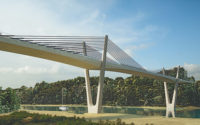Three years after the state of Connecticut failed to generate any bids on the nation’s first extradosed bridge project—a hybrid cable-stayed, box-girder structure—three firms now are competing for the superstructure work. The low bid is about $33 million below engineers’ estimate.

When bids were opened on June 3 for the Pearl Harbor Memorial Bridge, known as the Q bridge because it spans the Quinnipiac River, the joint venture of Walsh Construction Co., Sharon, Mass., and PCL Civil Constructors, Tampa, Fla., was the apparent low bidder at $417.2 million. Kiewit Construction Co., Woodcliff Lake, N.J., came in at $429.4 million and the joint venture of O&G Industries, Torrington, Conn., and Tutor Perini Corp., Sylmar, Calif., at $519.4 million. “We are very pleased and excited to get going,” says Brian Mercure, Connecticut Dept. of Transportation spokesman. It has 60 days to award the contract.
The bridge originally was put out for bid in May 2006, but there were no takers. ConnDOT reduced the scope and risk by breaking out the foundation work—a $137-million project awarded to Pittsfield, Maine-based Cianbro Cos. and Middlesex Corp., Littleton, Mass. —a force main relocation and approach packages.
The superstructure bid was offered with a concrete or steel alternative. Both Walsh and Kiewit chose concrete, while O&G chose steel. O&G would not comment, but a source familiar with the project expected both alternatives to be very competitive. William F. McEleney, director, National Steel Bridge Alliance, Cranston, R.I., says mill steel prices are below norm, which is about $800 per ton. “The cost of fabricated steel should not be a major factor in the bid even though we don’t know what Walsh and Kiewit had for prices,” he says. “We can only conclude there must have been other factors impacting the O&G/Perini bid.”
McEleney says the substructure was designed for concrete, and “a substructure designed for steel would have been smaller and expected to cost less.” He adds, “The phasing of construction contracts may result in bids that are not reflective of market conditions when bidding complete bridge projects.”
The three-span, 1,013-ft-long side-by-side bridge is being built between the existing Interstate 95 bridge and the vertical-lift Tomlinson Bridge, which carries U.S. Route 1 and rail traffic. When completed in 2016, the 10-lane bridge will replace the existing I-95 crossing. The new bridge will have a 515-ft-long center span and 249-ft-long side spans.
The Q bridge is part of a $2.2-billion, 7.5-mile-long Interstate corridor expansion project, centered in New Haven. The existing bridge is obsolete but still handles about 140,000 vehicles daily.



